Sabrina Amrani Gallery opens the season with the the miniature works of Waqas Khan
The pakistani miniature artist Waqas Khan returns to Sabrina Amrani Gallery, two years after his debut in Europe in the same space. These two years have been intense for the artist: He has exhibited in the most prestigious art fairs such as Art Basel, FIAC, Frieze London, Art Basel Hong Kong, Art Dubai, India Art Fair, Art Basel Miami and Art14 London; shown his work in multiple group shows in Vienna, New Delhi, Innsbruck, Madrid, Kraitchal, Kazan and Moscow; and he was shortlisted for the Jameel Prize 3. Furthermore, his work is now part of the permanent collection of the Victoria and Albert Museum. The Pakistani artist returns, after two years from his debut solo show in Europe, to Sabrina Amrani Gallery with new, intriguing and vibrant work. But his practice in these two years has not changed, it has evolved to bring to the viewer more exciting and endless seemingly moving compositions that are now even more intricate and miniature but evergrowing massive scales. The ink and gesture through the stroke are Waqas’ means of expression. A binary language in which the silence and the emptiness is so defining as ink. This dichotomy along with the small scale, transforms its own materiality to create a third dimension inscribed in the two dimensional paper, that shapes and clarifies a complex whole. The viewer becomes involved in a direct relationship with a work that reflects the abstract, pure thought inherent to the artist. Waqas paintings engage and do not give rise to obvious, elevating us to levels of sensations that are beyond what is evident. No dot, no line or mark drawn amongst the crowd of them that flood Khan’s work is superfluous. All contribute to form the perfect image of a social body and give meaning to it. The exhibition opens with ‘Breath of The Compassionate IV’ a work where the negative space is the protagonist. Inspired by the famous Islamic design formed by interlacing 8-point stars, Waqas gives a twist to this traditional arrangement to accommodate it to his own practice and technique. 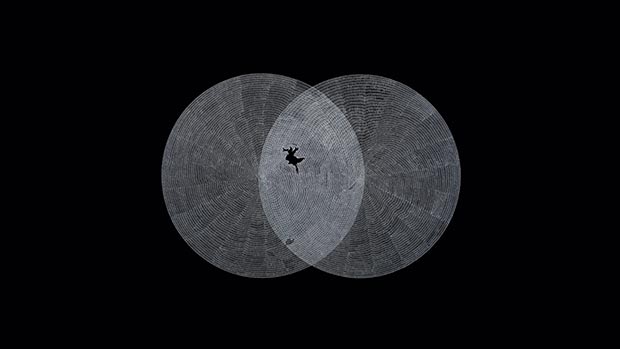 Waqas Khan / Breath of The Compassionate IV, 2014. Archival ink on wasli paper. 216x122 cm. Unique / Courtesy of Sabrina Amrani Gallery and the Artist
Waqas Khan / Breath of The Compassionate IV, 2014. Archival ink on wasli paper. 216x122 cm. Unique / Courtesy of Sabrina Amrani Gallery and the Artist 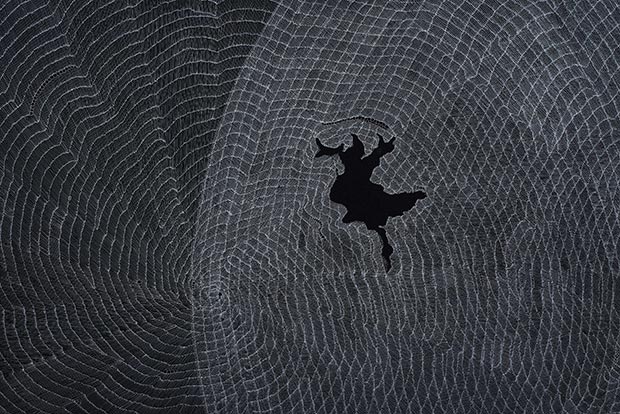 Waqas Khan / Detail of Breath of The Compassionate IV, 2014. Archival ink on wasli paper. 216x122 cm. Unique / Courtesy of Sabrina Amrani Gallery and the Artist The show continues with the works 'The Hole', 2014 and 'Untitled in Green', 2014 where the artist works with new shapes and colour to achieve a greater sense of movement in its own third self-created dimensionality.
Waqas Khan / Detail of Breath of The Compassionate IV, 2014. Archival ink on wasli paper. 216x122 cm. Unique / Courtesy of Sabrina Amrani Gallery and the Artist The show continues with the works 'The Hole', 2014 and 'Untitled in Green', 2014 where the artist works with new shapes and colour to achieve a greater sense of movement in its own third self-created dimensionality. 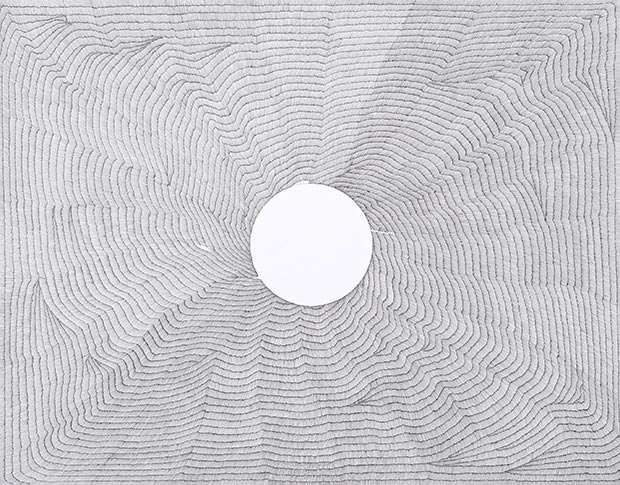 Waqas Khan / The Hole, 2014. Archival ink on wasli paper. 76x56 cm. Unique / Courtesy of Sabrina Amrani Gallery and the Artist
Waqas Khan / The Hole, 2014. Archival ink on wasli paper. 76x56 cm. Unique / Courtesy of Sabrina Amrani Gallery and the Artist  Waqas Khan / Detail of The Hole, 2014. Archival ink on wasli paper. 76x56 cm. Unique / Courtesy of Sabrina Amrani Gallery and the Artist Lastly, among other body of work such as 'Interruption II', 2014, one of the most complete works by the artist in terms of technique; Waqas Khan will also present sixteen new compositions of his series 'Forming Spaces', delicate studies of forthcoming works and techniques. Waqas uses this small format to experiment and toy with his own strokes, achieving new designs and ways of interwining the drawings that later he introduces into bigger scale works.
Waqas Khan / Detail of The Hole, 2014. Archival ink on wasli paper. 76x56 cm. Unique / Courtesy of Sabrina Amrani Gallery and the Artist Lastly, among other body of work such as 'Interruption II', 2014, one of the most complete works by the artist in terms of technique; Waqas Khan will also present sixteen new compositions of his series 'Forming Spaces', delicate studies of forthcoming works and techniques. Waqas uses this small format to experiment and toy with his own strokes, achieving new designs and ways of interwining the drawings that later he introduces into bigger scale works. 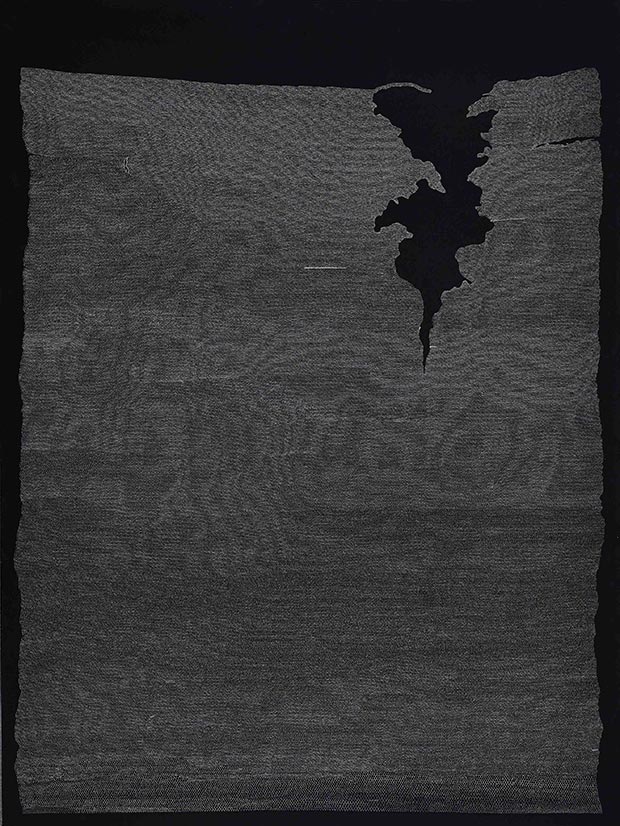 Waqas Khan / Interruption II, 2014. Archival ink on wasli paper. 103x76 cm. Unique / Courtesy of Sabrina Amrani Gallery and the Artist
Waqas Khan / Interruption II, 2014. Archival ink on wasli paper. 103x76 cm. Unique / Courtesy of Sabrina Amrani Gallery and the Artist
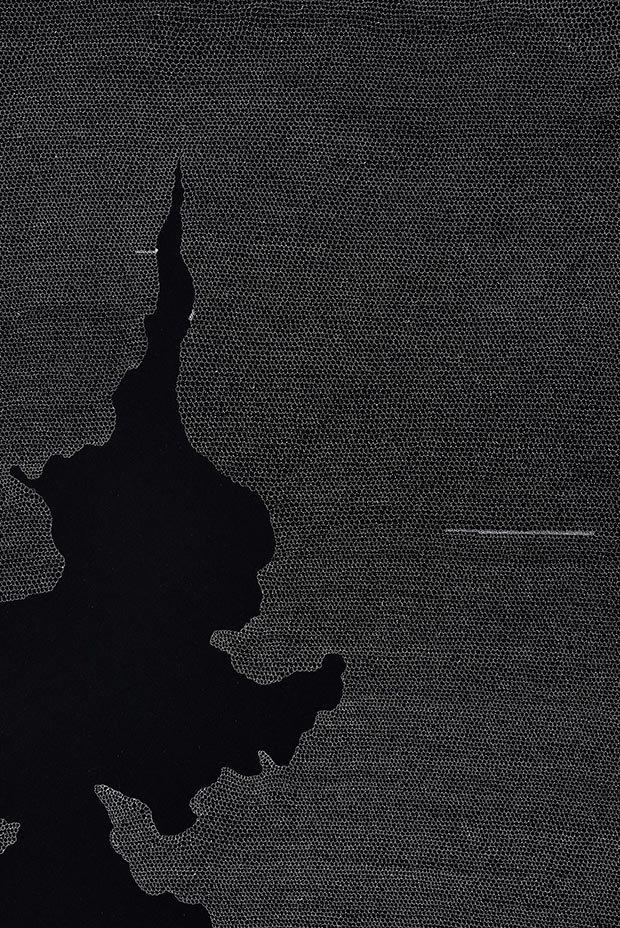 Waqas Khan / Detail of Interruption II, 2014. Archival ink on wasli paper. 103x76 cm. Unique / Courtesy of Sabrina Amrani Gallery and the Artist
Waqas Khan / Detail of Interruption II, 2014. Archival ink on wasli paper. 103x76 cm. Unique / Courtesy of Sabrina Amrani Gallery and the Artist
About Waqas Approach
Waqas works are one-single-tool-made meticulous surfaces intended for the eye of the viewer to be dancing endlessly on them, in the same way we sit silently and watch the world around us, gazing into the open wide sky full of stars or diving into the infinite depth of the ocean.The final purpose of his work is giving the viewer the opportunity to enjoy the beauty of visual infinity, the potential of philosophical awareness, and the visual effects produced inside the retina of the beholder, depending of the viewer's eye.
In order to draw the miniature traces and dots of ink that conform the works with the precision required, Waqas needs to hold his breath while drawing, and exhale after the ink is on the paper, sustaining that moment to celebrate pure and holly silence. This mind-numbing repetitive process, over and over during long non-stop hours of work, enables him to achieve works that evolve from simple dots into organic structures, patterns, contained space, volume and wonderfully refined mandala compositions, with a deceptive simplicity. The works do not look the same from different distances, this ambiguity is proposed by the artist as a playground for the mind.
Waqas only uses permanent ink, wasli paper and rotring pens as mediums to achieve his delicate and unique work. He does not use magnifying glasses or any kind of amplification lens to draw his paintings and he usually works during night time.
 Waqas Khan / Forming Spaces XI, 2014. Archival ink on wasli paper. 23x32 cm. Unique / Courtesy of Sabrina Amrani Gallery and the Artist
Waqas Khan / Forming Spaces XI, 2014. Archival ink on wasli paper. 23x32 cm. Unique / Courtesy of Sabrina Amrani Gallery and the Artist
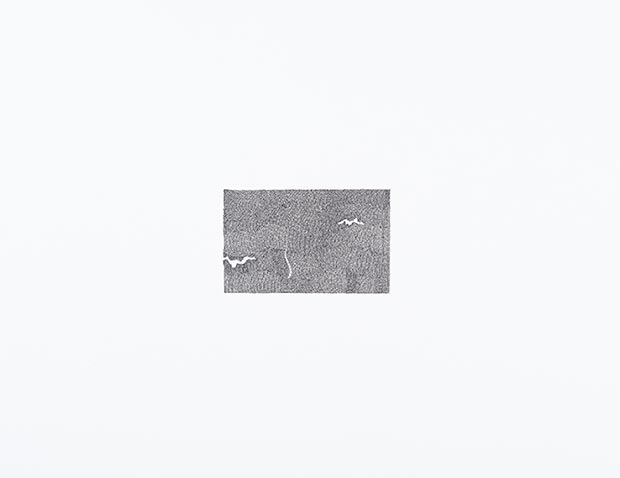 Waqas Khan / Forming Spaces XIX, 2014. Archival ink on wasli paper. 23x32 cm. Unique / Courtesy of Sabrina Amrani Gallery and the Artist
Waqas Khan / Forming Spaces XIX, 2014. Archival ink on wasli paper. 23x32 cm. Unique / Courtesy of Sabrina Amrani Gallery and the Artist
A Note by the Gallerist
"Artists create to awaken something in spectators. As an art gallery owner, my goal is to discover and share art. And both, artist and gallerist, feel fulfilled when the circle is completed, when the art we present connects with the viewer. I have carried the dots, lines and marks of Waqas’ works in my memory during months after discovering them and before receiving the new The Untitled Show pieces from Lahore, Pakistan. I remembered a landscape of dots and strokes in monochrome, such a microscopic world that the eyes need some time to wander around the artwork.
I usually work with conceptual artists that deal with socio-political issues and Waqas’ works, apparently abstract, tells us a lot about humanity. Under sufi and hindu influences, the artist invites us to contemplate: to stop for a moment and above all let our eyes the time to walk around on the paper, to adapt themselves to the chiaroscuros created by the different pressure of the hand while depositing the ink. I have lived for several weeks with these works and everytime I Iook at them, I see them in a different manner. They captivate me, obsess me, intrigue me... Circles, dots forming circles, lines made out of thousand of dots. The infinite can be touched in 'The Breath of the Compassionate 4', the fragility of life felt in 'Interruption II', its fatality in 'The Hole'.
But when I present Waqas’ work I can not help myself to go beyond what is visible. The process and technique with which Waqas deposits a load of ink on the paper requires concentration, dedication and patience and are the trait of a big generosity contained in every pigment and pore of the paper, with the sole intention of portraying beauty the way he perceives it, as a gift to the viewer, that is opened again with every blink.
That is what Waqas inspires me, an spiritual and generous personality that believes in the beauty of the world, a beauty expressed in minuscule dots and lines, a non-visible beauty at first sight without the effort of going in search of it. Waqas Khan’s art leaves his trace on every person, it is just a matter of taking the time and getting close enough."
Sabrina Amrani, Director of Sabrina Amrani Gallery
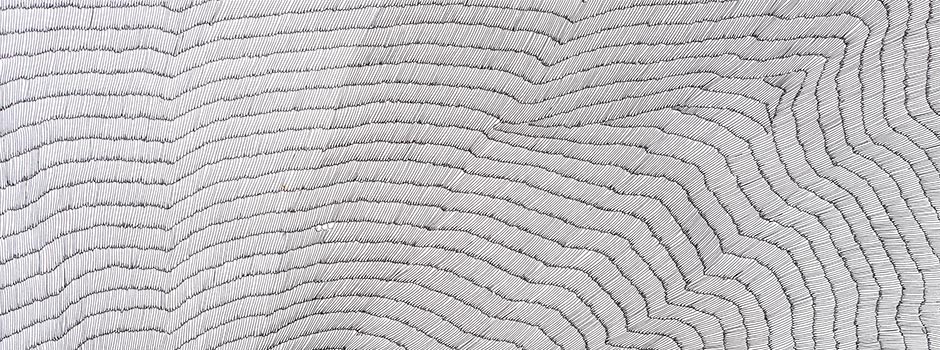
 Waqas Khan / Breath of The Compassionate IV, 2014. Archival ink on wasli paper. 216x122 cm. Unique / Courtesy of Sabrina Amrani Gallery and the Artist
Waqas Khan / Breath of The Compassionate IV, 2014. Archival ink on wasli paper. 216x122 cm. Unique / Courtesy of Sabrina Amrani Gallery and the Artist Waqas Khan / Detail of Breath of The Compassionate IV, 2014. Archival ink on wasli paper. 216x122 cm. Unique / Courtesy of Sabrina Amrani Gallery and the Artist
Waqas Khan / Detail of Breath of The Compassionate IV, 2014. Archival ink on wasli paper. 216x122 cm. Unique / Courtesy of Sabrina Amrani Gallery and the Artist Waqas Khan / The Hole, 2014. Archival ink on wasli paper. 76x56 cm. Unique / Courtesy of Sabrina Amrani Gallery and the Artist
Waqas Khan / The Hole, 2014. Archival ink on wasli paper. 76x56 cm. Unique / Courtesy of Sabrina Amrani Gallery and the Artist Waqas Khan / Detail of The Hole, 2014. Archival ink on wasli paper. 76x56 cm. Unique / Courtesy of Sabrina Amrani Gallery and the Artist
Waqas Khan / Detail of The Hole, 2014. Archival ink on wasli paper. 76x56 cm. Unique / Courtesy of Sabrina Amrani Gallery and the Artist Waqas Khan / Interruption II, 2014. Archival ink on wasli paper. 103x76 cm. Unique / Courtesy of Sabrina Amrani Gallery and the Artist
Waqas Khan / Interruption II, 2014. Archival ink on wasli paper. 103x76 cm. Unique / Courtesy of Sabrina Amrani Gallery and the Artist Waqas Khan / Detail of Interruption II, 2014. Archival ink on wasli paper. 103x76 cm. Unique / Courtesy of Sabrina Amrani Gallery and the Artist
Waqas Khan / Detail of Interruption II, 2014. Archival ink on wasli paper. 103x76 cm. Unique / Courtesy of Sabrina Amrani Gallery and the Artist Waqas Khan / Forming Spaces XI, 2014. Archival ink on wasli paper. 23x32 cm. Unique / Courtesy of Sabrina Amrani Gallery and the Artist
Waqas Khan / Forming Spaces XI, 2014. Archival ink on wasli paper. 23x32 cm. Unique / Courtesy of Sabrina Amrani Gallery and the Artist Waqas Khan / Forming Spaces XIX, 2014. Archival ink on wasli paper. 23x32 cm. Unique / Courtesy of Sabrina Amrani Gallery and the Artist
Waqas Khan / Forming Spaces XIX, 2014. Archival ink on wasli paper. 23x32 cm. Unique / Courtesy of Sabrina Amrani Gallery and the Artist
No comments:
Post a Comment